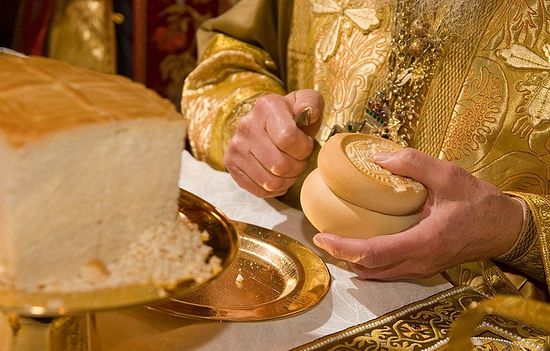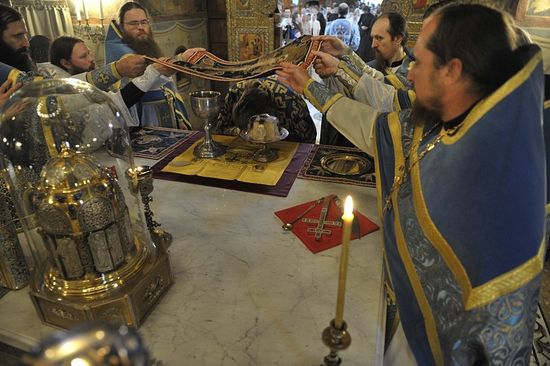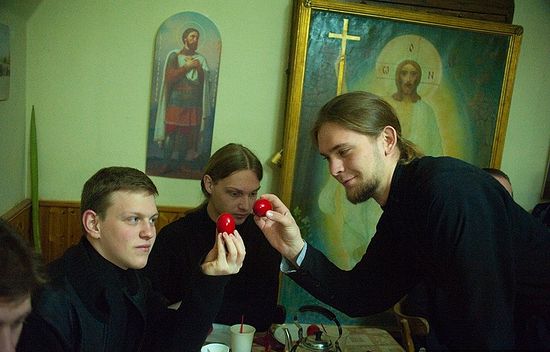SOURCE: iocc.org
Author: Ion Bria
In recent years, there has been a strong emphasis in Orthodox ecclesiology on the eucharistic understanding of the Church.
 |
| Photo: G.Balayants/Pravoslavie.ru |
The ecclesial koinonia is indeed constituted by the participation of the baptized in the eucharistic communion, the sacramental actualization of the economy of salvation, a living reality which belongs both to history and to eschatology.
While this emphasis is deeply rooted in the biblical and patristic tradition and is of extreme importance today, it might easily lead to the conclusion that Orthodox limit the interpretation of the Church to an exclusive worshipping community, to protecting and to preserving the Good News for its members.
Therefore a need was felt to affirm that the Liturgy is not a self-centred service and action, but is a service for the building of the one Body of Christ within the economy of salvation, which is for all people of all ages.
The liturgical assembly is the Father's House, where the invitation to the banquet of the heavenly bread is constantly voiced and addressed, not only to the members of the Church, but also to non-Christians and strangers.
This liturgical concentration, "the liturgy within the Liturgy," is essential for the Church, but it has to be understood in all its dimensions. There is a double movement in the Liturgy: on the one hand, the assembling of the people of God to perform the memorial of the death and resurrection of our Lord "until He comes again." It also manifests and realizes the process by which "the cosmos is becoming ecclesia."
Authentic testimony
Therefore the preparation for Liturgy takes place not only at the personal spiritual level, but also at the level of human historical and natural realities. In preparing for Liturgy, the Christian starts a spiritual journey which affects everything in his life: family, properties, authority, position and social relations. It re-orientates the direction of his entire human existence towards its sanctification by the Holy Spirit.
 |
| Liturgy in the Sretensky monastery |
On the other hand, renewed by the Holy Communion and the Holy Spirit, members of the Church are sent to be authentic witnesses to Jesus Christ in the world. The mission of the Church rests upon the radiating and transforming power of the Liturgy. It is a stimulus in sending out the people of God to the world to confess the Gospel and to be involved in man's liberation.
Liturgically, this continual double movement of thanksgiving is expressed in the ministry of the deacon. On the one hand, he brings and offers to the altar the gifts of the people; on the other, he shares and distributes the Holy Sacraments which nourish the life of Christians. Everything is linked with the central action of the Church, which is the Eucharist, and everybody has a diaconal function in reconciling the separated realities.
Enlarge the space for witness
How does the Church, through its liturgical life, invite the world into the Lord's House and seek the Kingdom to come? The actualization of this will be the great success of the Church's mission, not only because there is an urgent need for the Church to widen its vision of those outside its influence (Mt. 8:10), but also because the worshipping assembly cannot be a protected place any longer, a refuge for passivity and alienation.
In what sense does worship constitute a permanent missionary impulse and determine the evangelistic witness of every Christian? How does the liturgical order pass into the order of human existence, personal and social, and shape the lifestyle of Christians? In fact the witness of faith, which includes evangelism, mission and church life, has always taken place in the context of prayer, worship and communion. The missionary structures of the congregation were built upon the liturgy of Word and Sacrament. There was a great variety of liturgies, confessions and creeds in the first centuries of Christianity, as there is today.
"The liturgy after the Liturgy" which is an essential part of the witnessing life of the Church, requires:
1. An ongoing reaffirmation of the true Christian
identity, fullness and integrity which have to be
constantly renewed by the eucharistic communion.
2. To enlarge the space for witness by creating a new
Christian milieu, each in his own environment (family,
society, office, factory, etc.) is not a simple matter of
converting non-Christians in the vicinity of the parishes,
but also a concern for finding room where the Christians
live and work and where they can publicly exercise their
witness and worship.
3. The liturgical life has to nourish the Christian life
not only in its private sphere, but also in its public and
political realm. One cannot separate the true Christian
identity from the personal sanctification and love and
service to man (1 Pet. 1:14-15).
4. Liturgy means public and collective action and
therefore there is a sense in which the Christian is a
creator of community; this particular charisma has crucial
importance today with the increasing lack of human
fellowship in the society.
There is an increasing concern today about the ethical implications of the faith, in terms of lifestyle, social ethics and human behaviour. What is the ethos of the Church which claims to be the sign of the kingdom? What is the "spirituality" which is proposed and determined in spreading the Gospel and celebrating the Liturgy today? How is the liturgical vision which is related to the Kingdom, as power of the age to come, as the beginning of the future life which is infused in the present life (John 3:5; 6:33), becoming a social reality? What does sanctification or theosis mean in terms of ecology and human rights?
Koinonia of love
Christian community can proclaim the Gospel -- and be heard - only if it is a living icon of Christ. Christian equality and freedom in the Spirit, experienced in the Liturgy, should be expressed and continued in economic sharing and liberation in the field of social oppression.
 |
| Photo: G.Balayants/Pravoslavie.ru |
Christians have to be a continual builder of a true koinonia (community) of love and peace even if they are politically marginal and live in a hostile surrounding. At the ideological and political level, that koinonia may appear almost impossible.
It is very interesting to mention in this respect that St. John Chrysostom, who shaped the order of the eucharistic Liturgy ordinarily celebrated by Orthodox, strongly underlined "the sacrament of the brother," namely the spiritual sacrifice, the philanthropy and service which Christians have to offer outside the worship, in public places, on the altar of their neighbour's heart. For him there is a basic coincidence between faith, worship, life and service, therefore the offering on "the second altar" is complementary to the worship at the Holy Table.
There is much evidence to suggest that Orthodoxy is recapturing today that inner unity between the Liturgy, mission, witness and social diakonia, which gave it this popular character and historical vitality. The New Valamo Consultation (24-30 September 1977) confirmed once more the importance of the missionary concern for "liturgy after the Liturgy" within the total ecumenical witness of Orthodoxy.
The consultation declared: "In each culture the eucharistic dynamics lead into a 'liturgy after the Liturgy,' i.e. a liturgical use of the material world, a transformation of human association in society into koinonia, of consumerism into an ascetic attitude towards creation and the restoration of human dignity."
Thus, through "liturgy after the Liturgy," the
Church, witnessing to the cosmic dimension of the
salvation event, puts into practice, daily and
existentially, its missionary vocation.
